Practical Experience Of Computational Modelling Of Multi-Physics Problems
A summary report of the FENet Multi-physics and Analysis (MPA) workshop in Majorca, Spain, 25th -26th March 2004.
Introduction
All real world physical processes are multi-physics problems but there has not been sufficient capability to address the full physics of the problem in the past, so that there has been a tendency to simplify the problem by either focusing on the primary physics or to model the full physics in a decoupled or loosely coupled manner. For many applications this approach may be adequate, but there is an ever increasing demand for greater definition of the physical interactions and for better accuracy in the solution. As computing power increases the ability to model the full physics of a problem is becoming a practical possibility and the number of software tools now claiming multiphysics (MP) capability is growing steadily. Hence, there is an increasing demand for training in these tools. Earlier workshops have covered the following topics:
The ideas underlying multiphysics modelling and analysis, e.g. multi-disciplinary or multi-physics.
How to approach the setting up of problems involving multi-physics, e.g. levels of coupling for MP analysis, see Figure 1. For example, where there is low coupling between the physical phenomena, as in thermal-stress analysis, it may be sufficient to use simple one-way coupling with file transfer between two phenomena specific codes. However, each type of coupling has its own constraints. A problem with medium level of coupling will be subject to time step constraints for the different physics involved and will require a degree of compatibility in the mesh. A fully coupled MP solution must be both time and space accurate. In addition it will also require a degree of compatibility in the solver technologies and will often involve mesh movement, which may be accounted for either by use of the Arbitrary Lagrangian Eulerian (ALE) methods or by dynamic mesh techniques.
Emerging commercial multiphysics simulation technologies, e.g. software tools claiming coupling technologies [1], where the problem will be in terms of compatibility in the solution approach, accurate filtering and mapping of data and restarting or transient problems; or software tools claiming multiphysics (MP) capability [2,3,4,5,6].
MP in specific industry sectors, e.g. manufacturing and aero-space, see the FENet web site [7] for the MPA presentations.
The meeting held in Palma, Majorca, 25-26th March 2004 was a logical development on the MPA theme in that it was the first of a short series of Multi-Physics and Analysis (MPA) workshops, focusing on specific software tools, to be held over the forthcoming months. The objective of these practical MPA workshops is to give participant hands-on experience of implementing and running a series of MP problems of increasing difficulty using commercially available software with multi-physics capability.
The target multi-physics problem
The target MP problem was a simplified example of heat dissipation in an electronics component; see Figure 2 involving heat transfer, computational fluid dynamics, and structural mechanics.
Although this is a simple problem, it enabled the concurrent simulation of:
The physical coupling in this problem is fluid to thermal to fluid, i.e. two way and thermal to stress, i.e. one way. In setting up the problem for numerical solution, one must define the solution subdomain and the discretisation mesh; whilst for each of the phenomena, the surface areas or patches over which boundary conditions are applied must be defined, as well, as the specific definition of the physics involved. Hence, for each phenomenon, the continuum physics and the volume domain over which this is solved, the initial and boundary conditions and material properties must all be defined.
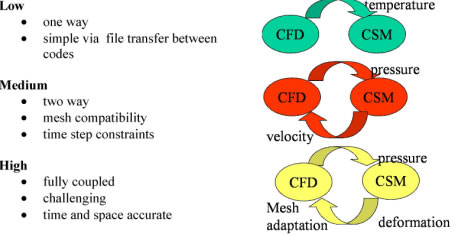
Figure 1 - Levels of coupling
2.1 Multi-physics modelling of the target problem
An incremental, three phase approach was used for modelling the target problem.
Heat transfer only.
Heat transfer with computational fluid dynamics.
The complete target problem - heat transfer with computational fluid dynamics and linear elastic stress, as seen in Figure 2.
This three-phase approach enabled the participants to become familiar with the software, in terms of pre and post processing and running a multiphysics application using a simple problem and to gradually build on the knowledge acquired over the two half days, to study the full MP target problem.
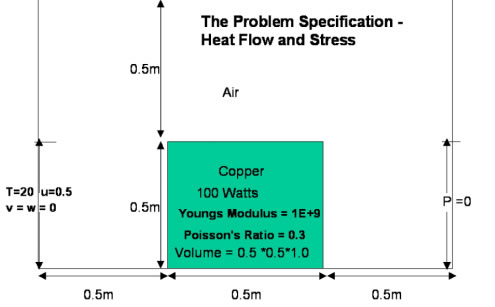
Figure 2. The target MP Problem
3 The workshop format
The MPA workshop was run over two half days and the participants were both users and developers of MPA software. The co-ordinators of this initial workshop were Professor Mark Cross and Dr. Avril Slone, who are experienced in the use of PHYSICA+ [6], hence it was decided that this software would be used for the workshop. The participants were guided through a number of steps in MP simulation, from problem definition, to setting up of PHYSICA data files, and visualisation of results, all the presentations given in this workshop are available on the FENet web site [7]. Participants were required to have access to a laptop with a CD drive, as the software, with documentation, examples and presentations would be uploaded to them. Each participant was provided with their own personal copy of the CD to keep, containing all this information. The software documentation is also available on-line, see [8].
3.1 An introduction to multiphysics modelling.
In the first session of the workshop, while the software was being uploaded, an introduction to MP modelling was given. The purpose of this presentation was to provide a common starting point from the perspective of multi-physics simulation and analysis. In this presentation there was also a brief survey of those software technologies claiming MP modelling capability. Fifteen CDs were distributed; of these four went to participants from Universities, four to software vendors or resellers, and seven to consulting CAE companies.
3.2 The second session
In the second session a specific presentation on Multi-physics Modelling in PHYSICA, was given, where the case study was introduced, see Figure 2. At this point, the necessary input files for PHYSICA were introduced, which involved the specification of two ASCII files:
.geo file, a complete geometry specification file, created using FEMGEN, which defines the problem domain, the boundary patches for all of the phenomena and the mesh
A file called inform, which contains problem dependant information, i.e. the specified physics, initial and boundary conditions and material properties, created using a text editor.
A full description of these files may be seen on the FENet web site, [7]. It was explained that PHYSICA runs over the whole mesh and operates the physics over each node or element.
However, for heat transfer or fluid flow, if the initial or boundary conditions have not been set in the inform file, then the default physical conditions would be applied. Further detail may be found in the accompanying documentation on the CD or on the web [8].
3.3 The first “hands on” session
In this session the participants were given an introduction to FEMGEN, [9], the pre-processor for PHYSICA+ and were guided through the writing of the geometry file – heat.geo, for the heat transfer by conduction only case and the necessary script file – inform. A batch file was provided on the CD for each participant to run PHYSICA from a command prompt on their own laptop. After running the simulation, the participants were introduced to the post-processor, FEMVIEW, [9].
Each participant was able to generate simulation results and produce the visualisations shown in Figure 3.
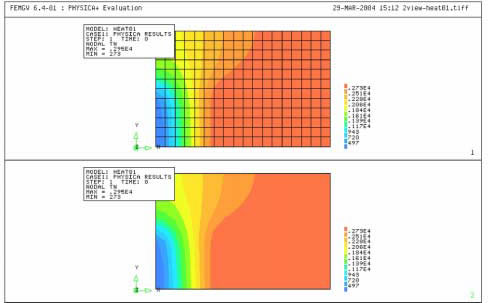
Figure 3 - Temperature contours for heat transfer case
For this case heat is diffusing from the heated copper cube throughout the domain at a rate of 100Ws-1 and is only lost through the left hand boundary. At steady state the rate of heat loss through this boundary must equal the heat generation rate from the copper cube. Considering the first cell from the left hand side (LHS) boundary, the energy balance equation is:

where is temperature at element centre,
is temperature at element centre,  is temperature at the face, i.e. LHS boundary, k is thermal conductivity, area is area of LHS boundary. Thus the temperature in the first cell from the LHS boundary is:
is temperature at the face, i.e. LHS boundary, k is thermal conductivity, area is area of LHS boundary. Thus the temperature in the first cell from the LHS boundary is:


This analysis compares well the simulation results. The maximum local temperature gradient will be at the LHS boundary and will decrease to zero further into the domain, as can be seem in the results. The maximum temperature difference from that at the LHS boundary will be in the RHS of the domain past the heated cube and from the results we see that this occurs near the top RHS of the domain.
3.4 The second “hands on” session
The second case was for heat transfer with fluid flow. For any transported variables on unset boundaries, the fluid flow module in PHYSICA has a default symmetry boundary condition. The geometry file for the heat transfer case was initially given sufficient boundary conditions to model fluid flow combined with heat transfer.
The participants were shown how to adapt the inform from the heat transfer case to include fluid flow, by simply switching on the flow module, adding initial and boundary conditions for fluid flow and enhancing the material property section to include the fluid viscosity. The participants ran the software and all produced the results shown in Figure 4.
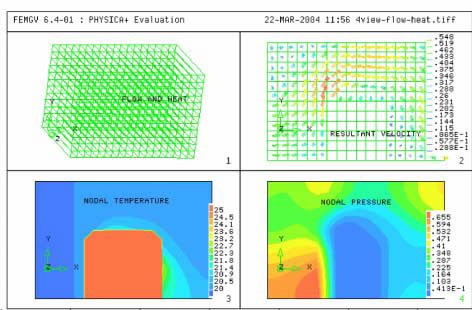
Figure 4 - Heat transfer with fluid flow
It is worth noting here the dominant effect of the convective flow past the copper cube, which reduces the temperature of the surrounding domain to be approximately that of the fluid at the inlet.
3.5 The third “hands on” session
Unlike the previous case, the heat transfer .geo did not have sufficient boundary patches specified for linear stress analysis. The participants were shown how to update the geometry file by adding additional boundary conditions for all degrees of freedom in the domain at y = 0 and to save it to another file name. The EVP (Elasto-visco-plastic) module requires a transient run, which for linear stress analysis was set to an infinite value.
Additional material properties, such as Young’s modulus, Poisson’s ratio, thermal expansion coefficient, yield stress, fluidity and plastic tangent are also needed and the participants were helped to amend the inform to include this information. The problem was run by all participants and the results were visualised using FEMVIEW, see Figure 5.
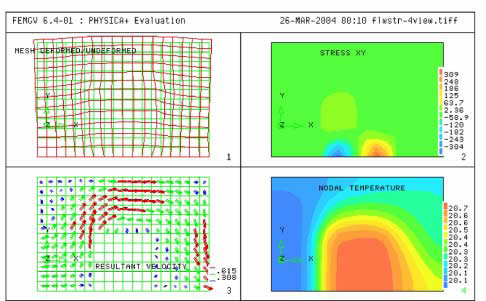
Figure 5 - Heat transfer, fluid flow and stress
3.6 The final session in the MPA workshop
The last session was a short round table discussion to enable the participants to express their views on the workshop and to reach some conclusions about its strengths and weaknesses. The consensus of the participants was that multi-physics modelling with PHYSICA was a relatively straightforward task but that there was a steep learning curve for those who were unfamiliar with the pre and post processing environment, FEMGV.
4 Conclusion
The principal objective of the workshop was to show that multiphysics analysis has matured over the past few years, to the point where it is now a usable technology by the engineering analysis community. The main challenges of the workshop were to:
Understand what is required of the user environment in defining problem geometry, boundary patches, and the solution mesh
Understand and set all the physics involved in the target problem, i.e., heat transfer, fluid dynamics, and linear stress analysis.
Set material properties, initial conditions, boundary conditions, and volume sources.
In all, there were twenty or so participants, of whom 15 survived the entire workshop. It was observed that although all participants found the workshop challenging, it was less so for those who were familiar with computational modelling and analysis as part of their daily routine.
For this “hands on” workshop the true measure of success can only be judged by the participants.
During the final session it became clear that the format of this workshop was, in the view of the participants, highly successful as they were all able to model all three stages of the target MP problem, i.e. thermal conduction including fluid flow and stress development. However, the lessons learnt were that in future “hands on” sessions there should be more emphasis on the aspects of multi-physics modelling and less emphasis on details of pre and post processing, which proved to be overly time consuming.
Thus, the recommendation following this workshop is that any other “hands on” workshop should give the participants the necessary input files and that the organisers, who are experienced in the tools for pre and post processing should give a live demonstration of how the input files were created and how to visualise the results.
5 References
1. MpCCI http://www.scai.fraunhofer.de/
2. ALGOR http://www.algor.com/products/Profes1730/default.asp
3. ANSYS 8.0 http://www.ansys.com/ansys/multiphysics.htm
4. CFD-ACE+ http://www.cfdrc.com/products/ace/index.html
5. FEMLAB 3 http://www.comsol.com/products/femlab/
6. PHYSICA+ http://www.multi-physics.com
7. FENet http://www.fe-net.org
8. PHYSICA documentation http://www.gre.ac.uk/~physica/documentation.htm
9. FEMSYS http://www.femsys.co.uk
Presentations
Introduction to Multi Physics Modelling
Avril Slone & Mark Cross, University of Greenwich
Introduction to FEMGV
Avril Slone & Mark Cross, University of Greenwich
Including Fluid Flow with Heat Transfer
Avril Slone & Mark Cross, University of Greenwich
CFD & Heat Transfer & Stress - a true multi-physics analysis
Avril Slone & Mark Cross, University of Greenwich
Adapting PHYSICA to your problems
Avril Slone & Mark Cross, University of Greenwich
Multi Physics Modelling in PHYSICA
Avril Slone & Mark Cross, University of Greenwich
Multi Physics for Real - an Action Workshop
Avril Slone & Mark Cross, University of Greenwich





 is temperature at element centre,
is temperature at element centre,  is temperature at the face, i.e. LHS boundary, k is thermal conductivity, area is area of LHS boundary. Thus the temperature in the first cell from the LHS boundary is:
is temperature at the face, i.e. LHS boundary, k is thermal conductivity, area is area of LHS boundary. Thus the temperature in the first cell from the LHS boundary is:




